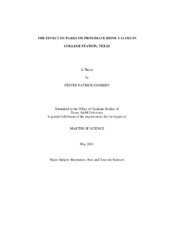| dc.contributor.advisor | Crompton, John | |
| dc.creator | Cooksey, Steven Patrick | |
| dc.date.accessioned | 2012-07-16T15:57:04Z | |
| dc.date.accessioned | 2012-07-16T20:16:54Z | |
| dc.date.available | 2012-07-16T15:57:04Z | |
| dc.date.available | 2012-07-16T20:16:54Z | |
| dc.date.created | 2011-05 | |
| dc.date.issued | 2012-07-16 | |
| dc.date.submitted | May 2011 | |
| dc.identifier.uri | https://hdl.handle.net/1969.1/ETD-TAMU-2011-05-9353 | |
| dc.description.abstract | Parks provide a multitude of benefits to communities that, while intuitive and easy to describe, are difficult to quantify. With public park departments being increasingly scrutinized in terms of dollars spent rather than merit value contributed to communities, the difficulty in quantifying those benefits presents a problem. Finding a method to apply monetary values to the contributions of parks in a community has become a prominent need for public parks departments.
One way to measure the monetary value of parks to a community is by examining the effects of those parks on the values of surrounding properties. This method assumes that the benefits offered by parks are capitalized into home prices such that prospective buyers are willing to pay premiums on properties that offer easy access to the parks and their benefits.
This study utilizes hedonic price modeling and multiple regression analyses to isolate the incremental value conferred on a home based on its proximity to a park. Parks were separated into three categories (regional, community, and neighborhood). Their spatial proximity to homes was measured by Geographic Information Systems and included in regressions along with structural, time, and neighborhood variables for each property. A golf course was also examined so that its effect on proximate home values could be compared to that of the parks.
Results suggested the most substantial impact of parks on home values was caused by the regional nature park, followed by the community parks. Neighborhood parks in the aggregate yielded no significant results. Even when these data were disaggregated so parks which had positive and negative influences were analyzed independently, there were no significant results. However, there was some suggestion that positive influences were associated with higher income level and a lower proportion of rental homes in an area. The golf course showed higher premiums than any of the parks, however, homes which were in the overlap of the influence zones of the regional park and golf course had the highest premiums, suggesting a compounding effect. | en |
| dc.format.mimetype | application/pdf | |
| dc.language.iso | en_US | |
| dc.subject | Parks | en |
| dc.subject | Proximate Principal | en |
| dc.title | The Effect of Parks on Proximate Home Values in College Station, Texas | en |
| dc.type | Thesis | en |
| thesis.degree.department | Recreation, Park, and Tourism Sciences | en |
| thesis.degree.discipline | Recreation, Park, and Tourism Sciences | en |
| thesis.degree.grantor | Texas A&M University | en |
| thesis.degree.name | Master of Science | en |
| thesis.degree.level | Masters | en |
| dc.contributor.committeeMember | Outley, Corliss | |
| dc.contributor.committeeMember | Wunneburger, Douglas | |
| dc.type.genre | thesis | en |
| dc.type.material | text | en |


